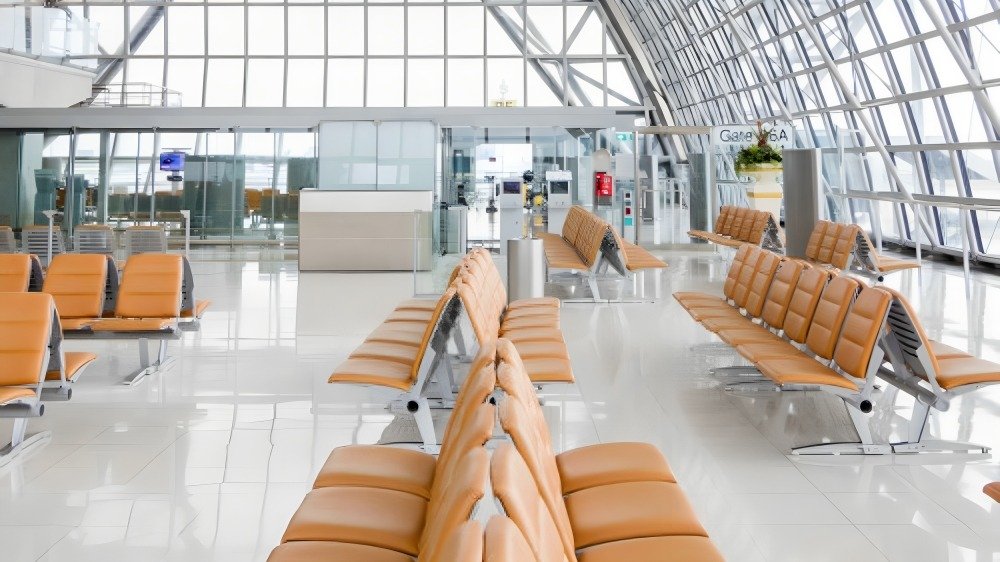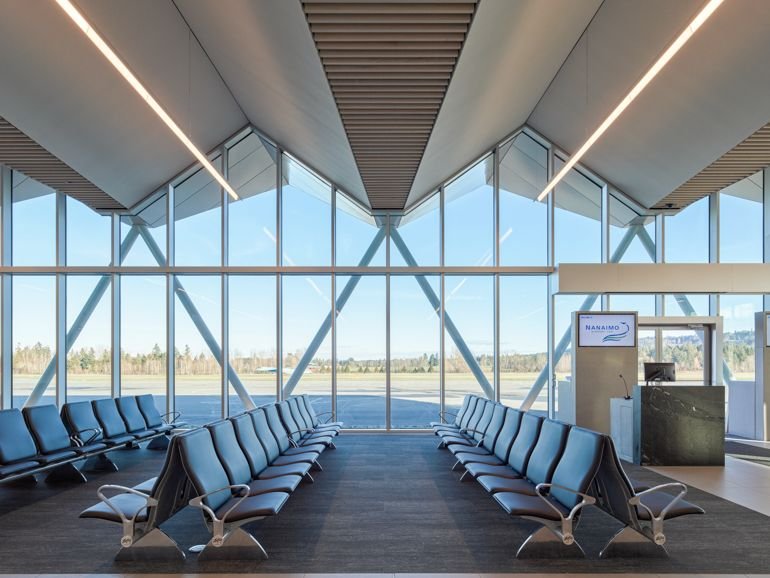Meta Description:
Turn airports and transportation hubs into luxurious, human-centered public spaces with elegant finishes, bespoke design, and immersive aesthetics.

Introduction: Where Design Meets Departure
Today’s travelers expect more than just a terminal and a ticket—they crave atmosphere, identity, and a sense of place. As the heartbeat of global movement, airports and transportation hubs have evolved into much more than waiting rooms. They are now curated experiences where luxury design can ease transitions, reflect cultural narratives, and offer calm amidst the chaos.
At Good House Interiors, we don’t just style spaces—we sculpt experiences. This blog offers an insider’s look at how thoughtful interior design transforms the world’s busiest crossroads into aesthetic landmarks. Whether you’re an airport developer, urban planner, or architect seeking luxury inspiration, this is your runway to ideas that soar.
The New Role of Airports and Transportation Hubs in Public Life
Modern hubs are public spaces on a monumental scale—blending hospitality, retail, culture, and logistics in one flowing environment. They demand a unique design approach that caters to:
- Thousands of simultaneous users
- Nonstop operations
- Diverse emotional states (from jet-lagged to jubilant)
- Cultural representation
When designed with intention, these hubs do more than guide people—they delight, de-stress, and even inspire.
Designing for Movement and Mood
Fluid Layouts for Seamless Flow
Forget the old boxy terminal layouts. Open-plan living isn’t just for homes—it’s key to transportation design. Curved corridors, intuitive sightlines, and layered zones ensure that travelers don’t feel lost or boxed in.
At Doha’s Hamad International Airport, for instance, soft transitions between check-in and lounge spaces mirror luxury hotel lobbies, allowing for a journey that feels less like a chore and more like a calm progression.
Lighting That Travels with You
In transit spaces, lighting isn’t just functional—it’s emotional infrastructure. Statement lighting can subtly guide foot traffic, highlight architectural features, and create a sense of place.
Consider pendant clusters that mimic constellations or softly backlit ceilings that mimic daylight—these aren’t just design choices, they are sensory cues that calm the mind and orient the traveler.
Bringing Hospitality into High-Traffic Spaces
Comfortable Zones, Not Cold Corridors
Luxury design hinges on comfort layered with character. In bustling hubs, this means sculpted seating areas, tactile materials, and acoustic solutions that hush the noise of the world. Think velvet-upholstered benches, reclaimed wood textures, or leather-bound charging pods.
Adding designer touches like textured fabrics or greenery creates moments of pause and privacy—vital for today’s overstimulated traveler.
Bespoke Furniture with a Purpose
Nothing says premium like custom-crafted furniture that fits both the space and the story. Whether it’s sculptural seating in an international terminal or locally inspired side tables in a metro station lounge, bespoke furniture adds identity. It’s the antidote to sterile, generic interiors.
Bonus? It allows for smart integration of tech and storage—style without sacrificing utility.
Elegant Finishes with Durability in Mind
High-end design doesn’t mean fragile. Public spaces need surfaces that can stand up to luggage wheels, coffee spills, and millions of footsteps—without losing their luster.
We recommend:
- Polished terrazzo or marble flooring for timeless elegance
- Brass detailing for a rich, enduring accent
- Stain-resistant fabrics with tactile appeal
- Natural elements like stone, wood, and greenery to soften the steel-and-glass atmosphere
These finishes help maintain a pristine look while signaling understated luxury.
Embedding Culture Through Architectural Details
Every transportation hub is a gateway to somewhere—and design should reflect that. From intricate ceiling patterns inspired by local artisanship to curated wall art representing regional landscapes, cultural storytelling through design creates a powerful first and last impression.
A great example? Singapore’s Changi Airport, where luxury and local flavor coexist in vertical gardens, koi ponds, and sculptural installations. It’s not just an airport—it’s a destination in itself.
Tips for Elevating Design in Airports and Transportation Hubs
- Prioritize intuitive navigation with visual cues instead of overwhelming signage
- Create multiple “mood zones”—calm corners, collaborative tables, lively food courts
- Invest in designer lighting to sculpt emotion and define areas
- Use modular, custom pieces that are easy to maintain and adapt
- Blend natural elements—plants, water features, natural light—to reduce stress
Conclusion: Step Into the Future of Luxurious Transit Spaces
Airports and transportation hubs are no longer architectural afterthoughts. They’re immersive experiences, gateways to the world, and reflections of national identity. When designed with elegance, intention, and user experience in mind, they become masterpieces of public space.
At Good House Interiors, we bring these spaces to life—merging architectural storytelling with luxurious finishes and bespoke furnishings. If you’re building or renovating a public hub, let’s design a space that turns transit into an experience worth remembering.
Contact us today for custom space planning, statement lighting design, or furniture that’s tailored to move people—literally and emotionally.
FAQ: Airports and Transportation Hubs Design
Q1: What are key elements in luxury airport interior design?
A balanced mix of bespoke furniture, premium finishes, ambient lighting, and intuitive flow ensures elegance meets function in high-traffic areas.
Q2: How can natural elements improve transit spaces?
Biophilic design—like plant walls, water features, and daylighting—helps reduce stress, boost traveler satisfaction, and make the space feel more human.
Q3: What finishes work best for durability and elegance?
Materials like terrazzo, treated stone, brushed metals, and performance textiles offer both beauty and resilience in large public areas.
Q4: Why should public spaces reflect local culture?
Embedding cultural identity builds emotional connections, adds authenticity, and turns generic transit points into memorable destinations.
Q5: Can luxury interior design fit within transportation budgets?
Absolutely. Strategic choices—like investing in signature elements rather than over-designing every corner—allow for impactful luxury within scope.

الفخامة أثناء التنقل: إعادة تعريف تصميم المطارات ومراكز النقل بمساحات داخلية راقية
وصف الميتا: حوّل المطارات ومراكز النقل إلى مساحات عامة فاخرة تتميز بتشطيبات أنيقة، وتصاميم مخصصة، وجماليات غامرة.
لم يعد المسافرون اليوم يكتفون بتذكرة ووجهة. إنهم يبحثون عن إحساس بالمكان، تجربة متكاملة، وبيئة تبعث على الراحة والانتماء. في قلب الحركة العالمية، تطورت المطارات ومراكز النقل لتصبح أكثر من مجرد نقاط عبور. إنها مشاهد مصممة بعناية يمكن أن تحكي قصة، تهدئ الأعصاب، وتضفي هوية معمارية مميزة.
في Good House Interiors، لا نكتفي بتأثيث المساحات—نصنع تجارب. في هذه المدونة، نأخذك في جولة داخلية لتكتشف كيف يمكن للتصميم الداخلي الفاخر أن يحوّل أكثر الأماكن ازدحامًا إلى معالم ذات طابع راقٍ. سواء كنت مطوّر مطارات، مخططًا حضريًا أو مهندسًا معماريًا، إليك دليل عملي ينبض بالأناقة والرؤية.
الدور الجديد للمطارات ومراكز النقل في الحياة العامة
أصبحت مراكز النقل الحديثة مساحات عامة متعددة الاستخدامات، تجمع بين الضيافة، البيع بالتجزئة، الثقافة، والخدمات اللوجستية. هذه البيئات تتطلب مقاربة تصميمية ذكية تستجيب لاحتياجات:
- عدد هائل من المستخدمين في الوقت نفسه
- تشغيل دائم بلا توقف
- تفاوت في الحالة النفسية للمسافرين
- تمثيل الهوية الثقافية للمكان
عندما يُنفذ التصميم بحرفية، لا تقتصر مهمته على توجيه الحركة بل يقدم تجربة حسية متكاملة تُسعد، وتُهدئ، وتُلهم.
التصميم من أجل الحركة والمزاج
تخطيطات انسيابية لحركة سلسة
نسيان التخطيطات التقليدية الضيقة أمر أساسي. التصميم المفتوح لا يقتصر على المنازل؛ بل هو جوهر مراكز النقل الحديثة. المسارات المنحنية، الخطوط البصرية الواضحة، والمناطق المتدرجة تخلق شعورًا بالراحة والانسياب.
في مطار حمد الدولي في الدوحة، على سبيل المثال، تمتزج مناطق الدخول والاستراحة بسلاسة تحاكي ردهات الفنادق الفاخرة، مما يجعل التنقل تجربة راقية وليست مرهقة.
إضاءة تواكب رحلتك
الإضاءة في هذه البيئات لا تؤدي وظيفة بصرية فقط، بل هي لغة عاطفية. يمكن للإضاءة التصميمية أن توجه الحركة، تُبرز العناصر المعمارية، وتخلق أجواء مختلفة في كل منطقة.
سواء كانت مصابيح معلّقة تشبه النجوم أو أسقف مضاءة تحاكي ضوء النهار، فهذه العناصر ليست مجرد تفاصيل بصرية، بل إشارات نفسية تُطمئن وتوجّه.
عناصر الضيافة في أكثر الأماكن ازدحامًا
مساحات مريحة وليست ممرات باردة
يكمن جوهر التصميم الفاخر في الراحة الممزوجة بالتميز. في البيئات العامة المزدحمة، يتحقق ذلك عبر مناطق جلوس مصممة، خامات حسية، وحلول صوتية تقلل الضوضاء. مقاعد مخملية، خشب مُعاد استخدامه، أو وحدات شحن مكسوّة بالجلد—كلها تخلق لحظات من السكون في وسط الزحام.
أثاث مخصص يخدم الهدف
لا شيء يُضفي الطابع الفاخر مثل الأثاث المصنوع حسب الطلب. من المقاعد المنحوتة في صالات المطارات الدولية إلى الطاولات الجانبية المستوحاة من الثقافة المحلية—يمنح الأثاث المصمم تفردًا ووضوحًا في الهوية.
والأهم؟ أنه يسمح بدمج ذكي للتقنيات ومساحات التخزين—الأناقة دون التخلي عن الوظيفة.
تشطيبات راقية… تدوم
لا يعني التصميم الراقي أنه هش. تحتاج المساحات العامة إلى خامات تتحمل العوامل اليومية دون أن تفقد بريقها.
ننصح باستخدام:
- أرضيات من التيرازو أو الرخام لمظهر خالد
- تفاصيل نحاسية فاخرة تدوم
- أقمشة مقاومة للبقع ذات لمسة ناعمة
- عناصر طبيعية مثل الخشب والحجر والنباتات لتلطيف الجو العام
تضمن هذه الخامات مظهرًا أنيقًا دائمًا مع قدرة عالية على التحمل.
إبراز الثقافة من خلال التفاصيل المعمارية
كل مركز نقل هو بوابة إلى قصة. يمكن أن يعبّر التصميم الداخلي عن هذه القصة من خلال الزخارف، الفنون الجدارية، أو الأنماط المستوحاة من التراث المحلي.
خذ مطار شانغي في سنغافورة مثالًا؛ النباتات العمودية، أحواض الأسماك، والمنحوتات التفاعلية، كلها تخلق تجربة فريدة. إنه ليس مجرد مطار، بل وجهة بحد ذاته.
نصائح لتصميم مراكز نقل فاخرة
- اعتمد توجيهًا بصريًا بسيطًا بدلًا من الإشارات المزدحمة
- أنشئ مناطق متعددة الحالات المزاجية—مريحة، اجتماعية، نابضة
- استثمر في الإضاءة التصميمية لتحديد المناطق والمزاج
- اختر أثاثًا مخصصًا سهل الصيانة والتعديل
- ادمج العناصر الطبيعية لتقليل التوتر وتعزيز الراحة
الختام: ارتقِ بمساحات العبور إلى تجارب لا تُنسى
لم تعد المطارات ومراكز النقل أماكن للمرور فقط. إنها لوحات معمارية نابضة بالحياة، تروي قصص المدن وتُمهّد لرحلات لا تُنسى. عندما تتناغم الهوية البصرية مع الفخامة والراحة، تتحول هذه المراكز إلى محطات تستحق التوقف عندها.
في Good House Interiors، نعيد تعريف هذه المساحات من خلال تخطيط ذكي، مفروشات فاخرة، وتفاصيل مصممة بعناية. هل تعمل على تطوير أو تجديد مركز نقل؟ دعنا نخلق معًا مساحة يتحرك فيها الناس وتشعرهم بالراحة والجمال.
تواصل معنا اليوم للحصول على خدمات تصميم مخصصة، تخطيط المساحات، أو استشارات حول اختيار التشطيبات والأثاث المناسب للمساحات العامة.
الأسئلة الشائعة
ما العناصر الأساسية في تصميم المطارات الفاخرة؟
مزيج من الأثاث المخصص، التشطيبات عالية الجودة، الإضاءة العاطفية، والتخطيطات الانسيابية لضمان تجربة راقية ومريحة.
كيف تُحسن العناصر الطبيعية من تجربة المسافرين؟
تصميم يعتمد على الطبيعة—مثل الجدران الخضراء أو الشلالات الداخلية—يقلل التوتر ويُحسن الراحة النفسية للمسافرين.
ما أفضل الخامات لتحمّل الاستخدام المكثف؟
تيرازو، الحجر الطبيعي، المعادن المعالجة، والأقمشة المقاومة للاهتراء توفر التوازن بين الجمال والعملية.
لماذا يجب أن تعكس مراكز النقل الثقافة المحلية؟
لأنها تخلق انطباعًا دائمًا، تعزز الانتماء، وتحول المطار من مساحة عبور إلى معلم يُعبّر عن روح المكان.
هل يمكن تنفيذ تصميم فاخر ضمن ميزانيات النقل؟
نعم، من خلال اختيار عناصر مميزة بعناية، يمكن تحقيق تأثير بصري راقٍ دون تجاوز الميزانية.
